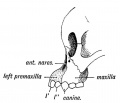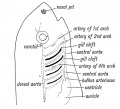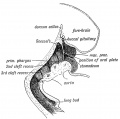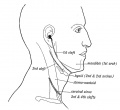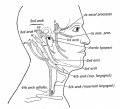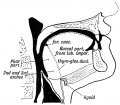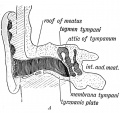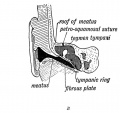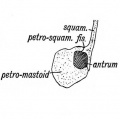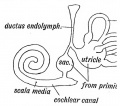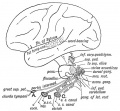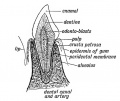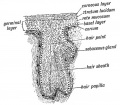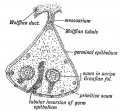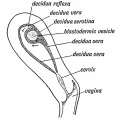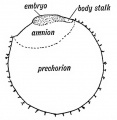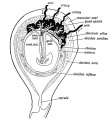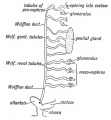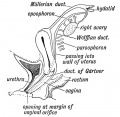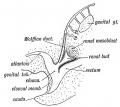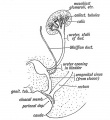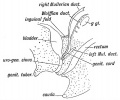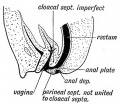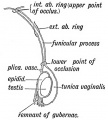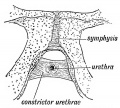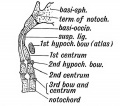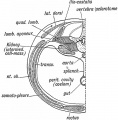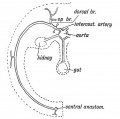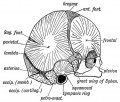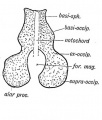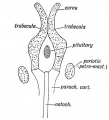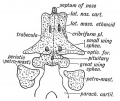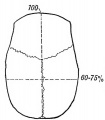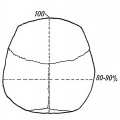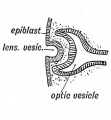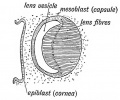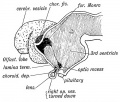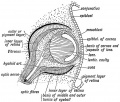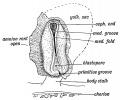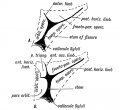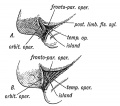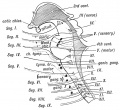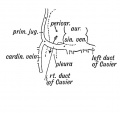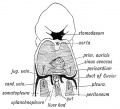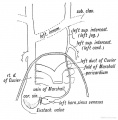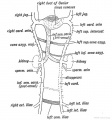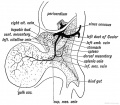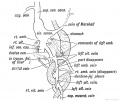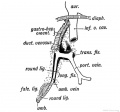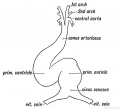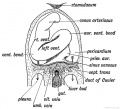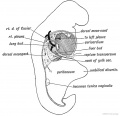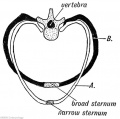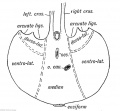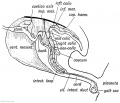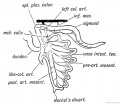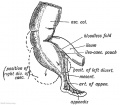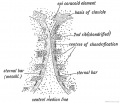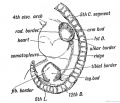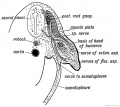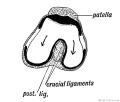Book - Human Embryology and Morphology Figures: Difference between revisions
mNo edit summary |
|||
| (37 intermediate revisions by the same user not shown) | |||
| Line 1: | Line 1: | ||
{{Human embryology morphology 1902 header}} | {{Human embryology morphology 1902 header}} | ||
Note some of these figures are the same as those used in the later [[Human Embryology and Morphology - Figures|1921 fourth edition]]. | |||
==Development or the Face== | ==Development or the Face== | ||
[[Book_-_Human_Embryology_and_Morphology_1|Development or the Face]] | [[Book_-_Human_Embryology_and_Morphology_1|Development or the Face]] | ||
<gallery> | <gallery> | ||
File:Keith1902 fig001.jpg|Fig. 1. Showing the formation of the face by the Nasal, Maxillary, and Mandibular processes in an embryo of the 4th week | File:Keith1902 fig001.jpg|Fig. 1. Showing the formation of the face by the Nasal, Maxillary, and Mandibular processes in an embryo of the 4th week. | ||
File:Keith1902 fig002.jpg|Fig. 2. Showing the parts of the face formed from the Nasal, Maxillary and Mandibular processes. | File:Keith1902 fig002.jpg|Fig. 2. Showing the parts of the face formed from the Nasal, Maxillary and Mandibular processes. | ||
File:Keith1902 fig003.jpg|Fig. 3. Showing the structures formed in the Mesial Nasal Processes. | File:Keith1902 fig003.jpg|Fig. 3. Showing the structures formed in the Mesial Nasal Processes. | ||
| Line 13: | Line 15: | ||
File:Keith1902 fig008.jpg|Fig. 8. Showing the ingrowth of the palatal plates of the two maxillary processes early in the 2nd month. (After Kollmann.) . | File:Keith1902 fig008.jpg|Fig. 8. Showing the ingrowth of the palatal plates of the two maxillary processes early in the 2nd month. (After Kollmann.) . | ||
File:Keith1902 fig009.jpg|Fig. 9. Showing the Hard Palate at birth. The premaxillary part is formed from the Mesial Nasal Processes ; the remainder by the Palatal Plates of the Maxillary Processes. | File:Keith1902 fig009.jpg|Fig. 9. Showing the Hard Palate at birth. The premaxillary part is formed from the Mesial Nasal Processes ; the remainder by the Palatal Plates of the Maxillary Processes. | ||
File:Keith1902 fig010a-c.jpg|Fig. 10, a, b, c. Showing what become of the skeletons of the Mandibular Arch (Meckel's Cartilage) and Maxillary Process (Palato-quadrate Cartilage) | File:Keith1902 fig010a-c.jpg|Fig. 10, a, b, c. Showing what become of the skeletons of the Mandibular Arch (Meckel's Cartilage) and Maxillary Process (Palato-quadrate Cartilage). | ||
File:Keith1902 fig010d.jpg|Fig. 10 D. Illustrating Gadow's view of the origin of the Auditory Ossicles and Tympanic Plate. | File:Keith1902 fig010d.jpg|Fig. 10 D. Illustrating Gadow's view of the origin of the Auditory Ossicles and Tympanic Plate. | ||
File:Keith1902 fig011.jpg|Fig. 11. Showing the manner in which the development of the Maxillary Antrum affects the size of the palate and position of the molar teeth. | File:Keith1902 fig011.jpg|Fig. 11. Showing the manner in which the development of the Maxillary Antrum affects the size of the palate and position of the molar teeth. | ||
File:Keith1902 fig012.jpg|Fig. 12. Showing the Centres of Ossification and age changes in the Lower Jaw. | File:Keith1902 fig012.jpg|Fig. 12. Showing the Centres of Ossification and age changes in the Lower Jaw. | ||
File:Keith1902 fig013.jpg|Fig. 13. The chief types of the Temporo-Maxillary Articulation. A. Carnivorous Type. B. Omnivorous Type. C. Herbivorous Type. | File:Keith1902 fig013.jpg|Fig. 13. The chief types of the Temporo-Maxillary Articulation. '''A.''' Carnivorous Type. '''B.''' Omnivorous Type. '''C.''' Herbivorous Type. | ||
File:Keith1902 fig014.jpg|Fig. 14. Showing the Chief Changes after birth in the form of the TemporoMaxillary Articulation. | File:Keith1902 fig014.jpg|Fig. 14. Showing the Chief Changes after birth in the form of the TemporoMaxillary Articulation. | ||
File:Keith1902 fig015a.jpg|Fig. 15 A. Sagittal Section showing the Stomodaeum and position of the Oral Plate in the 3rd week | File:Keith1902 fig015a.jpg|Fig. 15 A. Sagittal Section showing the Stomodaeum and position of the Oral Plate in the 3rd week. | ||
File:Keith1902 fig015b.jpg|Fig. 15 B. Showing the parts of the Buccal and Nasal Cavities formed from the Stomodaeum. The relative position of the Oral Plate is indicated. | File:Keith1902 fig015b.jpg|Fig. 15 B. Showing the parts of the Buccal and Nasal Cavities formed from the Stomodaeum. The relative position of the Oral Plate is indicated. | ||
</gallery> | </gallery> | ||
:'''Links:''' [[Head Development]] | [[Palate Development]] | |||
==The Nasal Cavities and Olfactory Structures== | ==The Nasal Cavities and Olfactory Structures== | ||
| Line 27: | Line 31: | ||
<gallery> | <gallery> | ||
File:Keith1902 fig016.jpg|Fig. 16. The Olfactory Pit and Nasal Processes in a 4th week human embryo | File:Keith1902 fig016.jpg|Fig. 16. The Olfactory Pit and Nasal Processes in a 4th week human embryo. | ||
File:Keith1902 fig017.jpg|Fig. 17. The Mesial aspect of the Brain of a human foetus, 3J months old, showing the Olfactory Lobe. | File:Keith1902 fig017.jpg|Fig. 17. The Mesial aspect of the Brain of a human foetus, 3J months old, showing the Olfactory Lobe. | ||
File:Keith1902 fig018.jpg|Fig. 18. Showing the parts formed out of the Olfactory Lobe in the brain of an Adult | File:Keith1902 fig018.jpg|Fig. 18. Showing the parts formed out of the Olfactory Lobe in the brain of an Adult, and the termination of the olfactory roots in the Sub-callosal and Uncinate Gyri. | ||
File:Keith1902 fig019.jpg|Fig. 19. A diagram of the Lateral Wall of the Nasal Cavity, showing the position of the Air Sinus. | File:Keith1902 fig019.jpg|Fig. 19. A diagram of the Lateral Wall of the Nasal Cavity, showing the position of the Air Sinus. | ||
File:Keith1902 fig020.jpg|Fig. 20. Showing on the inner wall of the Orbit (1) the position of the Infundibulum, (2) the pars facialis lachrymalis. | File:Keith1902 fig020.jpg|Fig. 20. Showing on the inner wall of the Orbit (1) the position of the Infundibulum, (2) the pars facialis lachrymalis. | ||
| Line 40: | Line 44: | ||
[[Book_-_Human_Embryology_and_Morphology_3|Development of the Pharynx and Neck]] | [[Book_-_Human_Embryology_and_Morphology_3|Development of the Pharynx and Neck]] | ||
<gallery> | <gallery> | ||
File:Keith1902 fig021a.jpg|Fig. 21a. | File:Keith1902 fig021a.jpg|Fig. 21a. Showing the Visceral Arches and Cleft-depressions in the Pharyngeal Wall of a 4th week human Embryo. Each Visceral Arch contains an Aortic Arch. (After His.) | ||
File:Keith1902 fig021b.jpg|Fig. 21b. Showing the position of the Heart, Visceral and Aortic Arches in a fish. (Diagrammatic — after Gegenbaur.) | File:Keith1902 fig021b.jpg|Fig. 21b. Showing the position of the Heart, Visceral and Aortic Arches in a fish. (Diagrammatic — after Gegenbaur.) | ||
File:Keith1902 fig022.jpg|Fig. 22. Showing the Primitive Pharynx of a 3rd week embryo in sagittal section, bounded by the Visceral Arches. (After His.) . | File:Keith1902 fig022.jpg|Fig. 22. Showing the Primitive Pharynx of a 3rd week embryo in sagittal section, bounded by the Visceral Arches. (After His.) . | ||
| Line 75: | Line 79: | ||
File:Keith1902 fig046.jpg|Fig. 46. Showing the Nerve Structures concerned in the Sense of Hearing. | File:Keith1902 fig046.jpg|Fig. 46. Showing the Nerve Structures concerned in the Sense of Hearing. | ||
</gallery> | </gallery> | ||
:'''Links:''' [[Sensory_-_Hearing_and_Balance_Development|Hearing Development]] | |||
==Development and Morphology of the Teeth== | ==Development and Morphology of the Teeth== | ||
| Line 97: | Line 103: | ||
File:Keith1902 fig054.jpg|Fig. 54. The more common patterns formed by the dermal papillae on the tips of the fingers. | File:Keith1902 fig054.jpg|Fig. 54. The more common patterns formed by the dermal papillae on the tips of the fingers. | ||
File:Keith1902 fig055.jpg|Fig. 55. Diagram of a Developing Hair. | File:Keith1902 fig055.jpg|Fig. 55. Diagram of a Developing Hair. | ||
File:Keith1902 fig056.jpg|Fig. 56. Diagrammatic Section across a | File:Keith1902 fig056.jpg|Fig. 56. Diagrammatic Section across a Nail. | ||
File:Keith1902 fig057.jpg|Fig. 57. Showing the various stages in tho development of the Mamma | File:Keith1902 fig057.jpg|Fig. 57. Showing the various stages in tho development of the Mamma | ||
File:Keith1902 fig058.jpg|Fig. 58. Diagrammatic Section of the Breast to show the arrangement of its Capsule and Lymphatics. | File:Keith1902 fig058.jpg|Fig. 58. Diagrammatic Section of the Breast to show the arrangement of its Capsule and Lymphatics. | ||
| Line 146: | Line 152: | ||
File:Keith1902 fig083.jpg|Fig. 83. The Origin of the Renal Bud (diagrammatic). | File:Keith1902 fig083.jpg|Fig. 83. The Origin of the Renal Bud (diagrammatic). | ||
File:Keith1902 fig084.jpg|Fig. 84. The Termination of the Ureter in the Bladder and Sub-division of the Renal Bud | File:Keith1902 fig084.jpg|Fig. 84. The Termination of the Ureter in the Bladder and Sub-division of the Renal Bud | ||
File:Keith1902 fig085.jpg|Fig. 85. A transverse section to show the manner in which the Wolffian and | File:Keith1902 fig085.jpg|Fig. 85. A transverse section to show the manner in which the Wolffian and Müllerian Ducts arite, and their position in the Wolffian Ridge. (After Kollmann.) . | ||
File:Keith1902 fig086.jpg|Fig. 86. Diagram of the Genital Ducts at -the commencement of the 3rd month of foetal life. Lateral view. | File:Keith1902 fig086.jpg|Fig. 86. Diagram of the Genital Ducts at -the commencement of the 3rd month of foetal life. Lateral view. | ||
File:Keith1902 fig087.jpg|Fig. 87. Diagram of the | File:Keith1902 fig087.jpg|Fig. 87. Diagram of the Müllerian Ducts at the commencement of the 3rd month. Ventral view. | ||
File:Keith1902 fig088.jpg|Fig. 88. Evolution of the Human Form of Uterua. A Form seen in lowest mammals, reptiles, amphibians, fishes, and in the 2nd month human foetus. B. Form of Mullerian Ducts in rodents. C. Form in Camivora, etc., and in the 4th month human foetus. D. Form found in man and higher primates. | File:Keith1902 fig088.jpg|Fig. 88. Evolution of the Human Form of Uterua. A Form seen in lowest mammals, reptiles, amphibians, fishes, and in the 2nd month human foetus. B. Form of Mullerian Ducts in rodents. C. Form in Camivora, etc., and in the 4th month human foetus. D. Form found in man and higher primates. | ||
File:Keith1902 fig089.jpg|Fig. 89. Showing the manner in which the Mulleriau Ducts fuse to form the Uterus and Vagina. | File:Keith1902 fig089.jpg|Fig. 89. Showing the manner in which the Mulleriau Ducts fuse to form the Uterus and Vagina. | ||
| Line 163: | Line 169: | ||
File:Keith1902 fig100.jpg|Fig. 100. A A section to show the condition of parts in Ectopia Vesicae. | File:Keith1902 fig100.jpg|Fig. 100. A A section to show the condition of parts in Ectopia Vesicae. | ||
File:Keith1902 fig101.jpg|Fig. 101. A diagram to show the position at which the Prostatic Tubules arise. | File:Keith1902 fig101.jpg|Fig. 101. A diagram to show the position at which the Prostatic Tubules arise. | ||
File:Keith1902 fig102.jpg|Fig. 102. The Position of the Testis in a foetus of | File:Keith1902 fig102.jpg|Fig. 102. The Position of the Testis in a foetus of 2.5 months . | ||
File:Keith1902 fig103.jpg|Fig. 103. Showing the Position of the Testis at the 6th month, and the Formation of the Gubernaculum Testis. | File:Keith1902 fig103.jpg|Fig. 103. Showing the Position of the Testis at the 6th month, and the Formation of the Gubernaculum Testis. | ||
File:Keith1902 fig104.jpg|Fig. 104. The manner in which the structures in the wall of the abdomen are carried out so as to form the Inguinal Canal and Coverings of the Testis. | File:Keith1902 fig104.jpg|Fig. 104. The manner in which the structures in the wall of the abdomen are carried out so as to form the Inguinal Canal and Coverings of the Testis. | ||
| Line 204: | Line 210: | ||
<gallery> | <gallery> | ||
Fig. 125. | File:Keith1902 fig125.jpg|Fig. 125. A transverse section showing the Elements of the 1st Lumbar Segment in the Adult. | ||
Fig. 126. | File:Keith1902 fig126.jpg|Fig. 126. A corresponding section of an Embryo about the end of the 3rd week (diagrammatic). | ||
Fig. 127. | File:Keith1902 fig127.jpg|Fig. 127. The distribution of a typical Segmental Artery. | ||
Fig. 128. | File:Keith1902 fig128.jpg|Fig. 128. Diagram of the Nerve System of the 11th Dorsal Segment. | ||
Fig. 129. | File:Keith1902 fig129.jpg|Fig. 129. A diagram showing the derivation of the Parts of the Nerve System of the 11th Segment in the Embryo. | ||
</gallery> | </gallery> | ||
| Line 215: | Line 221: | ||
<gallery> | <gallery> | ||
Fig. 130. | File:Keith1902 fig130.jpg|Fig. 130. The Centres of Ossification for the Dermal Bones of the Skull. The Bones which are formed in Cartilage are stippled. | ||
Fig. 131. | File:Keith1902 fig131.jpg|Fig. 131. A coronal section of the Skull of a Foetus, 4£ months old. | ||
Fig. 132. | File:Keith1902 fig132.jpg|Fig. 132. The Occipital Region in a Foetus of 5 months. | ||
Fig. 133. | File:Keith1902 fig133.jpg|Fig. 133. The Parachordal Cartilages out of which the Cartilaginous Parts of the Occipital Bone are formed. | ||
Fig. 134. | File:Keith1902 fig134.jpg|Fig. 134. The expansion backwards of the Parachordal Cartilages to enclose the Foramen Magnum and form the Supra-occipital. | ||
Fig. 135. | File:Keith1902 fig135.jpg|Fig. 135. Diagram of the Trabeculae Cranii, Parachordal Cartilages, and Periotio Capsules. | ||
Fig. 136. | File:Keith1902 fig136.jpg|Fig. 136. Diagram of the structures formed from the Trabeculae Cranii. | ||
Fig. 137. | File:Keith1902 fig137.jpg|Fig. 137. The Sphenoid in a foetus of 4 months. The Centres of Ossification are deeply shaded. (After Sappey.) | ||
Fig. 138. | File:Keith1902 fig138.jpg|Fig. 138. Diagram of a Long-head (Dolichocephalic). | ||
Fig. 139. | File:Keith1902 fig139.jpg|Fig. 139. Diagram of a Short-head (Brachycephalie). | ||
Fig. 140. | File:Keith1902 fig140.jpg|Fig. 140. The Facial Angle of alEuropean contrasted with that of an Anthropoid. | ||
</gallery> | </gallery> | ||
| Line 232: | Line 238: | ||
<gallery> | <gallery> | ||
Fig. 141. | File:Keith1902 fig141.jpg|Fig. 141. Diagram of the Elements which form the Eyeball. | ||
Fig. 142. | File:Keith1902 fig142.jpg|Fig. 142. Invagination of the Epiblast to form the Lena Vesicle. | ||
Fig. 143. | File:Keith1902 fig143.jpg|Fig. 143. The manner in which the Lens Vesicle is severed from the Epiblast. | ||
Fig. 144. | File:Keith1902 fig144.jpg|Fig. 144. The Formation of the Lens Fibres from the Epithelium on the posterior Wall of the Vesicle. | ||
Fig. 145. | File:Keith1902 fig145.jpg|Fig. 145. Diagram showing the condition of the Optic Stalk and Vesicle at the commencement of the 2nd month. (After His.) | ||
Fig. 146. | File:Keith1902 fig146.jpg|Fig. 146. Diagrammatic Section of the Optic Cup and Lens. | ||
Fig. 147. | File:Keith1902 fig147.jpg|Fig. 147. The Optic Stalk and Cut), viewed on the lower and lateral aspect, showing the closure of the Choroidul Fissure. | ||
Fig. 148. | File:Keith1902 fig148.jpg|Fig. 148. Diagrammatic Section of the Eye showing the Parts formed from the Mesoblast. (After His' Model of the eye of a 3rd mouth human embryo.) | ||
Fig. 149. | File:Keith1902 fig149.jpg|Fig. 149. Section of the Eye and Orbit at birth. | ||
Fig. 150. | File:Keith1902 fig150.jpg|Fig. 150. The Origin of the Bones entering into Formation of the Orbit. | ||
Fig. 151. | File:Keith1902 fig151.jpg|Fig. 151. Diagram of the Plica Semilunaris and Lachrymal Canaliculi. | ||
Fig. 152. | File:Keith1902 fig152.jpg|Fig. 152. Diagram of the Motor Nerves of the Muscles of the Eye derived from the 1st, 2nd, and 3rd Cephalic Segments. | ||
Fig. 153. | File:Keith1902 fig153.jpg|Fig. 153. Diagram of the Foetal Brain at the end of the 2nd month, showing the Position in which the Optic Tracts are developed. | ||
Fig. 154. | File:Keith1902 fig154.jpg|Fig. 154. Mesial Section of the brain of a Lizard showing the resemblance to the human foetal brain (Fig. 153) especially in the development of the Corpora Bigemina. | ||
Fig. 155. | File:Keith1902 fig155.jpg|Fig. 155. View of the Mesial Surface of the Brain in the 5th month. | ||
Fig. 156. | File:Keith1902 fig156.jpg|Fig. 156. Section of the Occipital Lobe at the position marked in Fig. 155. | ||
Fig. 157. | File:Keith1902 fig157.jpg|Fig. 157. Mesial Section of the Brain at the 4th week shewing the Rudiment of the Occipital Lobe. (After His.) | ||
</gallery> | </gallery> | ||
:'''Links:''' [[Sensory_-_Vision_Development|Vision Development]] | |||
==The Brain and Spinal Cord== | ==The Brain and Spinal Cord== | ||
| Line 255: | Line 264: | ||
<gallery> | <gallery> | ||
Fig. 158. | File:Keith1902 fig158.jpg|Fig. 158. Medullary Folds uniting to form the Neural Tube in a Human Embryo of about 14 days. (After Graf Spee.) | ||
Fig. 159. | File:Keith1902 fig159.jpg|Fig. 159. Diagram of the Four Primary Divisions of the Neural Tube. | ||
Fig. 160. | File:Keith1902 fig160.jpg|Fig. 160. Diagrammatic Section showing the three Zones of the Spinal Neural Tube at the Gth week. | ||
Fig. 161. | File:Keith1902 fig161.jpg|Fig. 161. Diagrammatic Section o£ the Spinal Cord to show the Parts formed in the three Zones of the Embryonic Spinal Cord. | ||
Fig. 162. | File:Keith1902 fig162.jpg|Fig. 162. Section across the Hind Brain of a Human Embryo in the 5th week. | ||
Fig. 163. | File:Keith1902 fig163.jpg|Fig. 163. Lateral view of the Cephalic Part of the Neural Tube in a 5th week human embryo. (After His.) | ||
Fig. 164. | File:Keith1902 fig164.jpg|Fig. 164. Diagram of the Attachments of the Inferior Medullary Velum in a 5th month foetus. (After Kollmann.) | ||
Fig. 165. | File:Keith1902 fig165.jpg|Fig. 165. Median Section of the Cerebellum and 4th Ventricle of a Frog. | ||
Fig. 166. | File:Keith1902 fig166.jpg|Fig. 166. Diagrammatic Section of the Cerebellum of a 3rd month Human Foetus showing the folding of the Cerebellar Plate. | ||
Fig. 167. | File:Keith1902 fig167.jpg|Fig. 167. A schematic figure to show the parts derived from the walls of the fore-brain. (After His.) | ||
Fig. 168. | File:Keith1902 fig168.jpg|Fig. 168. Transverse Section of the brain of a Human Foetus at the commencement of the 3rd month to show the Cerebral Vesicles overlapping the Thalamencephalon. | ||
Fig. 169. | File:Keith1902 fig169.jpg|Fig. 169. Diagrammatic Section across the 3rd Ventricle of the Adult to show the Structures formed in its Walls. | ||
Fig. 170. | File:Keith1902 fig170.jpg|Fig. 170. A dorsal view of the Fore and Mid-brain at the 5th week of development to show the formation of the Velum Interpositum. | ||
Fig. 171. | File:Keith1902 fig171.jpg|Fig. 171. Mesial Aspect of the human Foetal Brain during the 4th month. (After Minot.) | ||
Fig. 172. | File:Keith1902 fig172.jpg|Fig. 172. Diagram to show the structures formed in the Lamina Terminalis and Primitive Callosal Gyrus. (After Elliot Smith.) | ||
Fig. 173. | File:Keith1902 fig173.jpg|Fig. 173. Showing the Development of the Corpus Striatum in the floor and outer wall of the Cerebral Vesicle. | ||
Fig. 174. | File:Keith1902 fig174.jpg|Fig. 174. Lateral Aspect of the Cerebral Hemisphere during the 2nd month. | ||
Fig. 175. | File:Keith1902 fig175.jpg|Fig. 175. The same Aspect during the 5th month. | ||
Fig. 176. | File:Keith1902 fig176.jpg|Fig. 176. The same Aspect during the 7th month. | ||
Fiq. 177. | File:Keith1902 fig177.jpg|Fiq. 177. Diagram of the Opercula and Fissure of Sylvius. In A the orbital operculum is undivided ; in B it is subdivided. (After Cunningham.) | ||
Fig. 178. | File:Keith1902 fig178.jpg|Fig. 178. The Island of Reil and Fissures on the lateral Aspect of the Brain of a dog-like Ape. | ||
Fig. | File:Keith1902 fig179.jpg|Fig. 179A. The more common Condition of the Island of Reil in Anthropoids. Fig. 179B. The complete isolation of the Island of Reil, the condition seen constantly in the Human Brain and occasionally in the Anthropoid. | ||
Fig. 180. | File:Keith1902 fig180.jpg|Fig. 180. A Diagram to show the Relationship of the Cranial Nerves to the Primitive Segments of the Head. | ||
</gallery> | </gallery> | ||
| Line 284: | Line 293: | ||
<gallery> | <gallery> | ||
Fig. 181. | Keith1902 fig181.jpg|Fig. 181. The Superior Vena Cava of the Adult. | ||
Fig. 182. | Keith1902 fig182.jpg|Fig. 182. The Embryonic Venous Trunks out of which the Superior Vena Cava is formed. | ||
Fig. 183. | Keith1902 fig183.jpg|Fig. 183. Diagram to show the manner in which the Ducts of Cuvier encircle the Coelom at the junction of the Pericardial and Pleural Parts. | ||
Fig. 184. | Keith1902 fig184.jpg|Fig. 184. The Remnants of the Left Superior Vena Cava, derived from the Structures shown in Fig. 185. | ||
Fig. 185. | Keith1902 fig185.jpg|Fig. 185. Diagram of the Sinus Venosus and Ducts of Cuvier of the human embryo about the 3rd week. | ||
Fig. 186. | Keith1902 fig186.jpg|Fig. 186. The Remnants of the Posterior Cardinal Veins in the Adult. | ||
Fig. 187. | Keith1902 fig187.jpg|Fig. 187. The Left Vitelline Vein of an Embryo of the 4th week. | ||
Fig. 188. | Keith1902 fig188.jpg|Fig. 188. Diagram showing the Formation of the Ductus Venosus, and the fate of the Umbilical and Vitelline veins. | ||
Fig. 189.-Diagram of the Kemnants of the Umbilical Vein in the Adult-viewed from behind. | Keith1902 fig189.jpg|Fig. 189.-Diagram of the Kemnants of the Umbilical Vein in the Adult-viewed from behind. | ||
Fig. 190. | Keith1902 fig190.jpg|Fig.190. Diagram of the Right Umbilical Vein in an embryo of 3 weeks, before the outgrowth of the Liver Bud | ||
Fig. 191. | Keith1902 fig191.jpg|Fig.191. Transverse section of the Blastoderm showing the Right and Left Cardiac Tubes situated in the Splanchnopieure. | ||
Fig. 192. | Keith1902 fig192.jpg|Fig.192. Transverse section at a more advanced stage showiDg the union of the Splanchnopleures to form the Mesocardia and the fusion of the Right and Left Cardiac Tubes. | ||
Fig. 193. | Keith1902 fig193.jpg|Fig.193. Lateral view of the Heart and Pericardium to show the Attachments of the Dorsal and Ventral Mesocardia. | ||
Fig. 194. | Keith1902 fig194.jpg|Fig.194. The Primitive Divisions of the Heart. | ||
Fig. 195. | Keith1902 fig195.jpg|Fig.195. Showing the two chief Bends which occur in the Heart during the 3rd week. | ||
Fig. 196. | Keith1902 fig196.jpg|Fig.196. Showing the Structures formed from the Sinus Venosus. | ||
Fig. 197. | Keith1902 fig197.jpg|Fig.197. Section of the Heart of a 5th week human foetus showing the Right and Left Venous Valves which guard the entrance of the Sinus Venosus into the Primitive Auricle. | ||
Fig. 198. | Keith1902 fig198.jpg|Fig.198. Diagram of the Septa of the Heart viewed on the right side. | ||
Fig. 199. | Keith1902 fig199.jpg|Fig.199. Section of the Ventricles of the Foetal Heart, showing the Muscular Sponge Work within their Cavities. | ||
Fig 200. | Keith1902 fig200.jpg|Fig 200. The origin of the semilunar valves. | ||
Fig 201 | Keith1902 fig201.jpg|Fig 201. The Form of the Coelom in a 3rd week Embryo as viewed from the right side. | ||
Fig. 202 | Keith1902 fig202.jpg|Fig. 202. Diagram to show the manner in which the heart is fixed within the pericardium by the Arterial and Venous Mesocardia in a human embryo of 3 weeks. | ||
Keith1902 fig203.jpg|Fig. 203. View of the interior of the Pericardium showing the attachments of the heart to its dorsal aspect by the Arterial or Venous Mesocardia. | |||
</gallery> | </gallery> | ||
| Line 312: | Line 322: | ||
<gallery> | <gallery> | ||
Fig. 204. | Keith1902 fig204.jpg|Fig. 204. Floor of the Pharynx and Oesophagus of a human embryo of 3 weeks showing; the Furcula, Pulmonary Groove, and Diverticulum. | ||
Fig. 205. | Keith1902 fig205.jpg|Fig. 205. A section of a human embryo to show the Relationships oJ the Pulmonary Buds at the 4th week. | ||
Fig. 206. | Keith1902 fig206.jpg|Fig. 206. The condition of the Bight and Left Pulmonary Buds in a 5th week embryo. (After His). | ||
Fig. 207. | Keith1902 fig207.jpg|Fig. 207. Scheme of the Bronchial Ramifications in Quadrupedal Mammals. | ||
Fig. 208. | Keith1902 fig208.jpg|Fig. 208. Diagrammatic Section of the Thorax of a Quadrupedal Mammal (A), contrasted with a corresponding section in Man (B). | ||
Fig. 209. | Keith1902 fig209.jpg|Fig. 209. The Relationship of the Heart to the Diaphragm in Quadrupedal Mammals. | ||
Fig. 210. | Keith1902 fig210.jpg|Fig. 210. Diagram of the Diaphragm to show the Parts formed by each of the five Elements. | ||
Fig 211 | Keith1902 fig211.jpg|Fig 211. Diagrammatic section behind the Embryonic Heart to show the Part of the primitive Mesentery which forms the mesial Element of the Diaphragm. | ||
</gallery> | </gallery> | ||
| Line 326: | Line 336: | ||
<gallery> | <gallery> | ||
Fig. 212. | Keith1902 fig212.jpg|Fig. 212. The Mesentery of the Fore-gut and its Contents, -viewed from the left side (schematic). | ||
Fig. 213. | Keith1902 fig213a.jpg|Fig. 213 A. The origin of the Peritoneal Ligaments connected with the Liver. | ||
Fig. 214. | Keith1902 fig213b.jpg|Fig. 213 B. The origin of the Peritoneal Ligaments connected with the Liver. | ||
Fig. 215 | Keith1902 fig214.jpg|Fig. 214. Diagram of a mammalian Liver viewed from behind and below. | ||
Fig. 216 | Keith1902 fig215.jpg|Fig. 215. The lower surface of the Liver of a human foetus during the 3rd month, showing Vestiges of Fissures and Lobes of the typical mammalian Liver. | ||
Fig. 217. | Keith1902 fig216.jpg|Fig. 216. The Relationship of the Spleen, Pancreas, and Liver to the Mesogastrium in the Embryo. | ||
Fig. 218. | Keith1902 fig217.jpg|Fig. 217. A diagrammatic transverse Section of the Mesogastrium viewed from behind. | ||
Fig. 219. | Keith1902 fig218.jpg|Fig. 218. The Pancreatic and Hepatic Processes of a 4th week human embryo. (After Kollmann.) | ||
Fig. 220. | Keith1902 fig219.jpg|Fig. 219. The Arrangement of Vessels in the Dorsal week (diagrammatic). | ||
Fig. 221. | Keith1902 fig220.jpg|Fig. 220. Diagram to show the Formation of the Lesser Sac of the Peritoneum from the Dorsal Mesogastrium. | ||
Fig. 222. | Keith1902 fig221.jpg|Fig. 221. The Form of the Alimentary Canal in a human embryo of the 3rd week. | ||
Fig. 223 A. | Keith1902 fig222.jpg|Fig. 222. The Form of the Alimentary Canal during the 5th week. | ||
Fig. 223 B. | Keith1902 fig223a.jpg|Fig. 223 A. The mesentery of the hind-gut. The Position assumed by the Colon after the rotation of the Gut has taken place. | ||
Fig. 224. | Keith1902 fig223b.jpg|Fig. 223 B. Diagram to show how the descending Meso-colon becomes applied to the parietal Peritoneum of the left Lumbar Region. | ||
Fig. 225 A. | Keith1902 fig224.jpg|Fig. 224. Diagram of the Apex of the Caecum at the time of birth and the Diverticula which may be produced in the Fundus of the Caecum afterwards. | ||
Fig. 225 B. | Keith1902 fig225a.jpg|Fig. 225 A.The Appendix and Peritoneal Folds at the end of the 2nd month of foetal life. The Intestinal Loop is viewed from the left side. | ||
Fig. 226. | Keith1902 fig225b.jpg|Fig. 225 B. Peritoneal Fossae in the lleo-caecal Region. | ||
Keith1902 fig226.jpg|Fig. 226. To show the Rotation of the Intestinal Loop and Formation of the Duodenojejunal Fossa. | |||
</gallery> | </gallery> | ||
| Line 349: | Line 360: | ||
<gallery> | <gallery> | ||
Fig. 227. | Keith1902 fig227.jpg|Fig. 227. Diagram of the Structures formed in the Median Ventral Line of the Body. | ||
Fig. 228. | Keith1902 fig228.jpg|Fig. 228. The Median Ventral Line in an embryo of three weeks, to contrast with the Corresponding Line in the Adult. | ||
Fig. 229. | Keith1902 fig229.jpg|Fig. 229. Scheme of the Manner in which the Somatopleure is segmented. | ||
Fig. 230. | Keith1902 fig230.jpg|Fig. 230. The Form of Sternum in a Pronograde (quadrupedal) Mammal. | ||
Fig. 231. | Keith1902 fig231.jpg|Fig. 231. The Form of Sternum in a Mammal adapted to the orthograde (upright) Posture. The Points of Ossification are also shown. | ||
Fig. 232. | Keith1902 fig232.jpg|Fig. 232. The Sternal Bars in a human embryo of six weeks (after Paterson). | ||
</gallery> | </gallery> | ||
| Line 362: | Line 373: | ||
<gallery> | <gallery> | ||
Fig. 233. | Keith1902 fig233.jpg|Fig. 233. Lateral view of a human embryo at the 28th day, showing the Limb Buds, Lateral Edges, and Primitive Segments. | ||
Fig. 234. | Keith1902 fig234.jpg|Fig. 234. Development of the Upper Limb. | ||
Fig. 235. | Keith1902 fig235.jpg|Fig. 235. Development of the Lower Limb. | ||
Fig. 236. | Keith1902 fig236.jpg|Fig. 236. The Corresponding Points {A, B, C, and D) in the Ilium and Scapula. | ||
Fig. 237. | Keith1902 fig237.jpg|Fig. 237. Section of the Arm Bud of a human embryo at the end of the 4th week. | ||
Fig. 238. | Keith1902 fig238.jpg|Fig. 238. Schematic Section showing the Origin and Arrangement of the Muscles and Nerves of the Limbs. | ||
Fig. 239. | Keith1902 fig239.jpg|Fig. 239. The Distribution of the Posterior Roots of the Spinal Nerves on the Flexor Aspect of the Arm. | ||
Fig. 240. | Keith1902 fig240.jpg|Fig. 240. Diagram to show the typical Manner in which the Posterior Nerve Roots are distributed in the Lower Limb. | ||
Fig. 241. | Keith1902 fig241.jpg|Fig. 241. Flexor Aspect of the Lower Limb showing the Sensory Distribution of the Segmental or Spinal nerves. | ||
Fig. 242. | Keith1902 fig242.jpg|Fig. 242. Diagram of the Pelvic Girdle of a Lizard. | ||
Fig. 243. | Keith1902 fig243.jpg|Fig. 243. The Pelvic Girdle of a Human Foetus at the 5th week. | ||
Fig. 244. | Keith1902 fig244.jpg|Fig. 244. The Shoulder Girdle of Ornithorynchus. | ||
Fig. 245. | Keith1902 fig245.jpg|Fig. 245. The Parts in the Shoulder Girdle of a human foetus which correspond with those of Ornithorynehus. | ||
Fig. 246. | Keith1902 fig246.jpg|Fig. 246. The Carpal Bones of a Tortoise. | ||
Fig. 247. | Keith1902 fig247.jpg|Fig. 247. The Os Trigenum and Bones of the Tarsus | ||
Fig. 248. | Keith1902 fig248.jpg|Fig. 248. The Foetal and Adult (in dotted outline) Forma of the Astralagus contrasted. | ||
Fig. 249. | Keith1902 fig249.jpg|Fig. 249. Latissimo-condyloideus Muscle. | ||
Fig. 250. | Keith1902 fig250.jpg|Fig. 250. The Morphology of the Short Muscles of the Digits. | ||
Fig. 251. | Keith1902 fig251.jpg|Fig. 251. Showing the Origin of the Ligamentum Teres and Reflected Bundle of the Capsular Ligament. | ||
Fig. 252. | Keith1902 fig252.jpg|Fig. 252. Showing the Origin of the Crucial Ligaments of the Knee. | ||
</gallery> | </gallery> | ||
{{Human embryology morphology 1902 footer}} | {{Human embryology morphology 1902 footer}} | ||
Latest revision as of 13:01, 28 December 2014
| Embryology - 18 Apr 2024 |
|---|
| Google Translate - select your language from the list shown below (this will open a new external page) |
|
العربية | català | 中文 | 中國傳統的 | français | Deutsche | עִברִית | हिंदी | bahasa Indonesia | italiano | 日本語 | 한국어 | မြန်မာ | Pilipino | Polskie | português | ਪੰਜਾਬੀ ਦੇ | Română | русский | Español | Swahili | Svensk | ไทย | Türkçe | اردو | ייִדיש | Tiếng Việt These external translations are automated and may not be accurate. (More? About Translations) |
Keith A. Human Embryology and Morphology. (1902) London: Edward Arnold.
| Historic Disclaimer - information about historic embryology pages |
|---|
| Pages where the terms "Historic" (textbooks, papers, people, recommendations) appear on this site, and sections within pages where this disclaimer appears, indicate that the content and scientific understanding are specific to the time of publication. This means that while some scientific descriptions are still accurate, the terminology and interpretation of the developmental mechanisms reflect the understanding at the time of original publication and those of the preceding periods, these terms, interpretations and recommendations may not reflect our current scientific understanding. (More? Embryology History | Historic Embryology Papers) |
Note some of these figures are the same as those used in the later 1921 fourth edition.
Development or the Face
- Links: Head Development | Palate Development
The Nasal Cavities and Olfactory Structures
The Nasal Cavities and Olfactory Structures
- Links: Smell Development
Development of the Pharynx and Neck
Development of the Pharynx and Neck
Development of the Organ of Hearing
Development of the Organ of Hearing
- Links: Hearing Development
Development and Morphology of the Teeth
Development and Morphology of the Teeth
- Links: Tooth Development
The Skin and its Appendages
- Links: Integumentary Development
The Development of the Ovum of the Foetus from the Ovum of the Mother
The Development of the Ovum of the Foetus from the Ovum of the Mother
The Manner in which a Connection is Established between the Foetus and Uterus
The Manner in which a Connection is Established between the Foetus and Uterus
The Uro-genital System
Formation of the Pubo-femoral Region, Pelvic Floor and Fascia
Formation of the Pubo-femoral Region, Pelvic Floor and Fascia
The Spinal Column and Back
The Segmentation of the Body
The Cranium
Development of the Structures concerned in the Sense of Sight
Development of the Structures concerned in the Sense of Sight
- Links: Vision Development
The Brain and Spinal Cord
Development of the Circulatory System
Development of the Circulatory System
The Respiratory System
The Organs of Digestion
The Body Wall, Ribs, and Sternum
The Body Wall, Ribs, and Sternum
The Limbs
| Historic Disclaimer - information about historic embryology pages |
|---|
| Pages where the terms "Historic" (textbooks, papers, people, recommendations) appear on this site, and sections within pages where this disclaimer appears, indicate that the content and scientific understanding are specific to the time of publication. This means that while some scientific descriptions are still accurate, the terminology and interpretation of the developmental mechanisms reflect the understanding at the time of original publication and those of the preceding periods, these terms, interpretations and recommendations may not reflect our current scientific understanding. (More? Embryology History | Historic Embryology Papers) |
Human Embryology and Morphology (1902): Development or the Face | The Nasal Cavities and Olfactory Structures | Development of the Pharynx and Neck | Development of the Organ of Hearing | Development and Morphology of the Teeth | The Skin and its Appendages | The Development of the Ovum of the Foetus from the Ovum of the Mother | The Manner in which a Connection is Established between the Foetus and Uterus | The Uro-genital System | Formation of the Pubo-femoral Region, Pelvic Floor and Fascia | The Spinal Column and Back | The Segmentation of the Body | The Cranium | Development of the Structures concerned in the Sense of Sight | The Brain and Spinal Cord | Development of the Circulatory System | The Respiratory System | The Organs of Digestion | The Body Wall, Ribs, and Sternum | The Limbs | Figures | Embryology History
Reference
Keith A. Human Embryology and Morphology. (1902) London: Edward Arnold.
Cite this page: Hill, M.A. (2024, April 18) Embryology Book - Human Embryology and Morphology Figures. Retrieved from https://embryology.med.unsw.edu.au/embryology/index.php/Book_-_Human_Embryology_and_Morphology_Figures
- © Dr Mark Hill 2024, UNSW Embryology ISBN: 978 0 7334 2609 4 - UNSW CRICOS Provider Code No. 00098G





